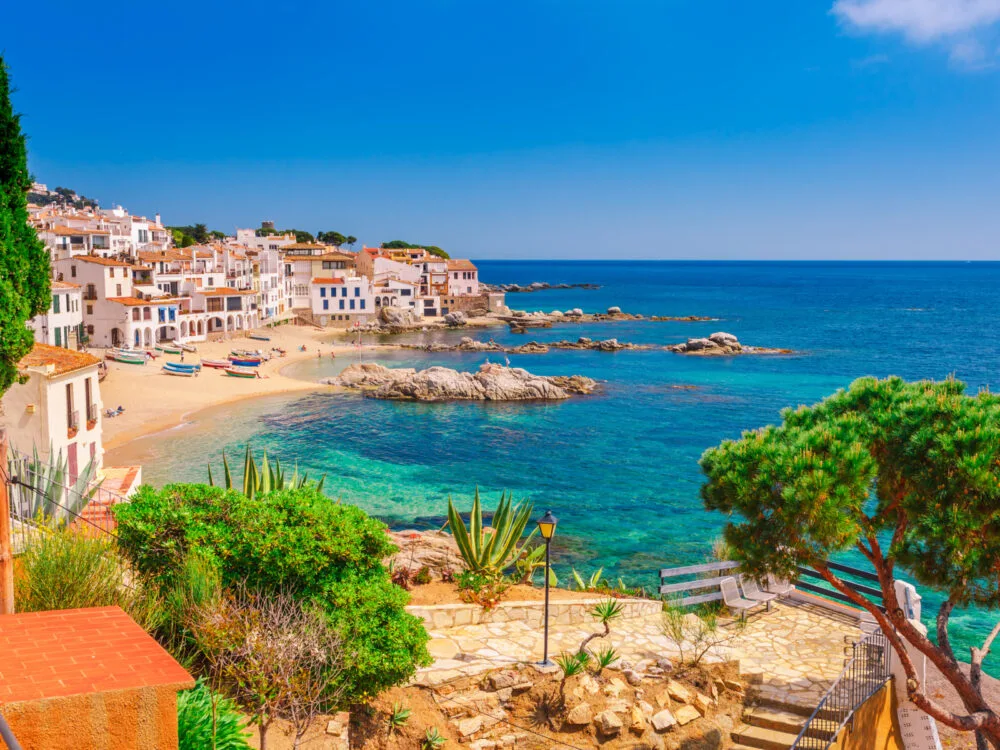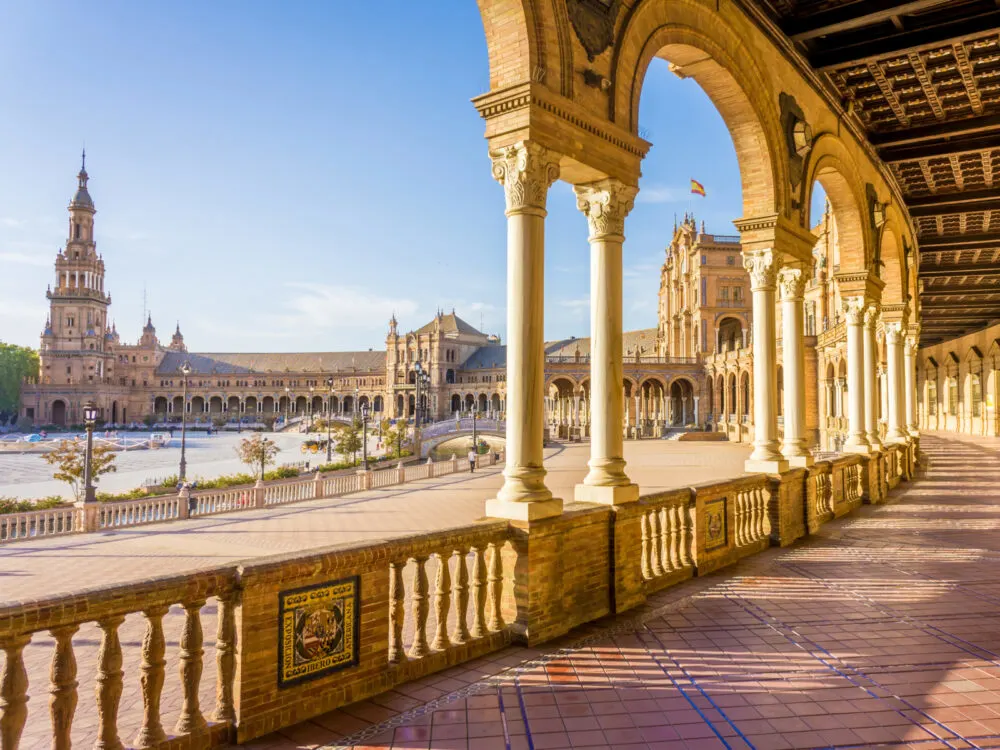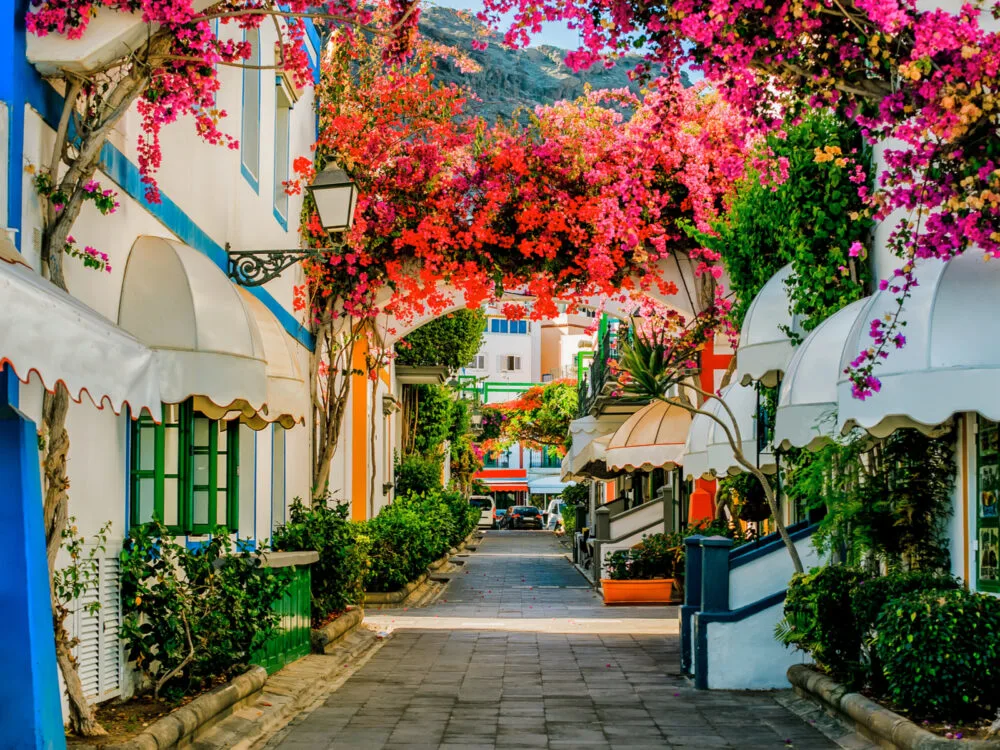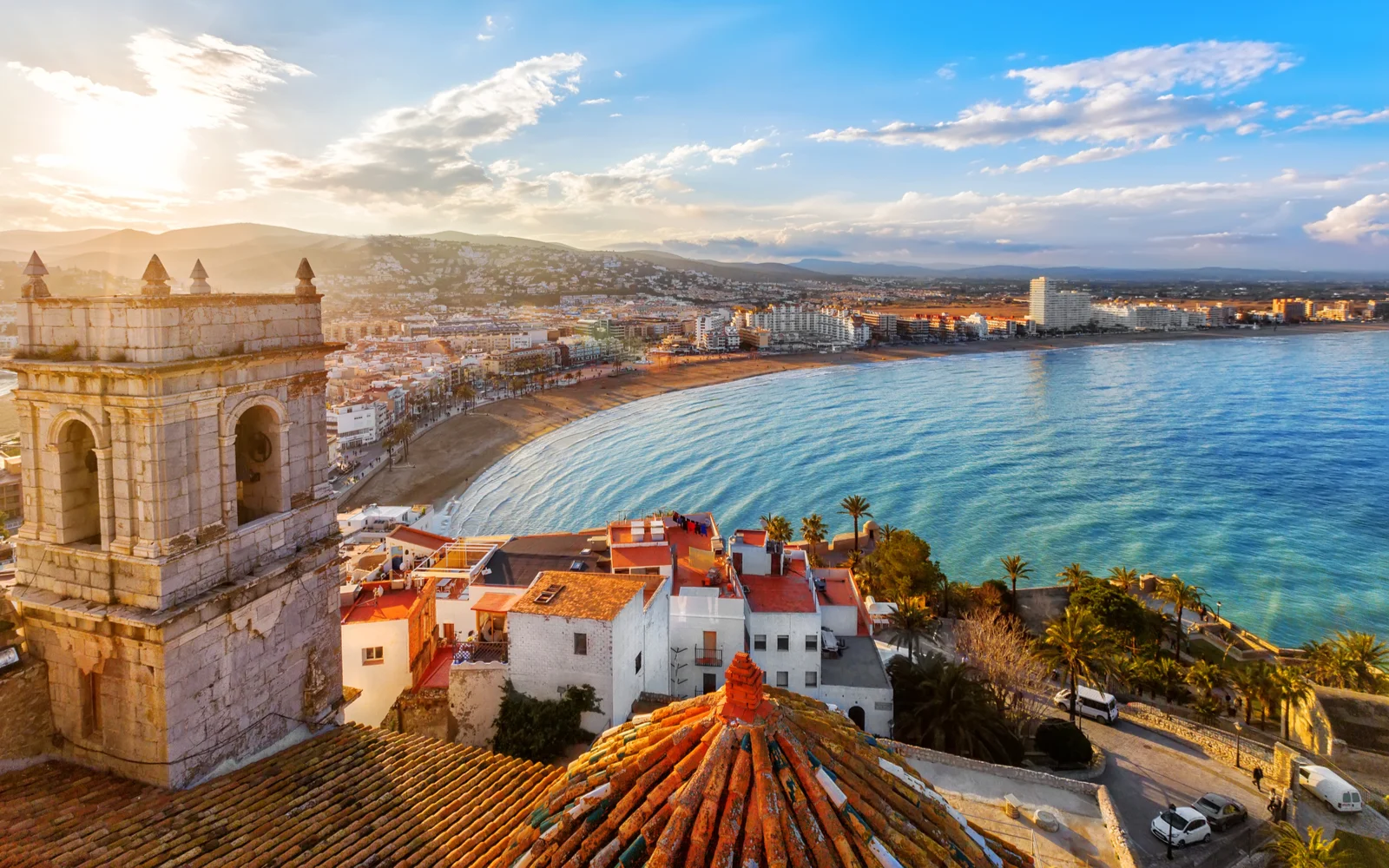What's the best time to visit Spain?
The best time to visit Spain is between May-June or September-October, with each shoulder season period offering mild, warm weather and plenty of events, like the Ibiza Medieval Festival and National Day festivities. Crowds and prices aren’t at their peak during these months, so you can enjoy an affordable, laid-back trip with sightseeing and beach days on the coasts and islands.
Spain is delightfully diverse with rich history and architecture, world-famous cuisine, picturesque landscapes, and colorful cultural traditions that have stood the test of time. But if you’re planning a trip soon, you’ll need to know the best time to visit Spain.
Seasonal climates are the first consideration when picking out the right travel dates. Spain isn’t huge — a bit smaller than the state of Texas — but elevation and proximity to the coast can affect the temperature and how much rain (or snow) different regions get throughout the year.
Spain has an incredibly varied landscape, from sun-soaked beaches on the coast and offshore islands to the Sierra Nevada mountains in the south. So while one month can be perfect for Barcelona or Canary Islands beaches, it could still be cold and snowy down south.
Other trip planning considerations are cost and crowds. Peak season periods mean higher prices on hotels and flights, while the off-season is when you’ll find better deals and fewer tourists at hotels, restaurants, and attractions in Spain’s most popular cities.
All these factors fit into the puzzle that is determining the best time to visit Spain. We’ll show you the overall best months along with the cheapest, least busy, and worst months for a trip to Spain below.
You’ll also get to see what you can expect during each period as far as weather patterns, costs, crowds, and things to do. This will help you pinpoint the right travel dates for your trip to Spain and make the most of your time in this beautiful country!
Overall Best Time to Visit Spain

Oleg_P/Shutterstock
The best time to visit Spain is May to June and September to early October. These shoulder season periods see warm, mostly dry weather that’s ideal for sightseeing and exploring major cities, coastal and island beaches, and outdoor activities.
The weather across Spain varies quite a bit in terms of rainfall, but average highs generally hang within a 10° range nationwide, no matter the location. By visiting between May-June or September-October, you’ll avoid the hottest months of the year with highs in the 90s:
- May: 65-75°F; 2-9 rainy days
- June: 71-84°F; 0-6 rainy days
- September: 73-82°F; 2-7 rainy days
- October: 67-74°F; 5-11 rainy days
There’s a little more rain in the northern and western regions in May, September, and October, but the most-visited cities, like Barcelona, Madrid, and Ibiza, usually get the lower end of the rain averages.
This is the best time of year to visit Barcelona for sightseeing and to hit the golden coastal beaches. Hang out on La Barceloneta while things are warm and lively. Explore famous museums, like the Picasso Museum, and awe-inspiring architecture and parks, like Gaudi’s La Sagrada Familia and Parque Guell with its whimsical tilework.
This is the perfect time to walk around Barcelona’s historic and funky barrios (neighborhoods), sample some seafood paella, enjoy flavorful tapas late at night, or take in a flamenco show to really immerse yourself in Spanish culture.
You won’t find a better time to enjoy Mallorca, one of Spain’s Balearic Islands with idyllic beaches and mountains, world-famous nightlife in Palma (the capital), Moorish and Roman palace ruins, and medieval cathedrals and villages built from stone.
Head to Playa de Muro or Playa de Alcudia for picturesque white sand and turquoise waters with tons of beachfront amenities as views of the mountains surround you. Secluded coves, like Sa Calobra, offer a break from crowds with dramatic cliffs and rock formations.
Party-centric Ibiza is excellent during May-June and September-October since you’ll skip the busiest months of July and August but still enjoy warm weather and a lively atmosphere at the clubs, bars, and restaurants.
While milder September and October are some of the busiest months of the year in Spain, they’re not the most expensive. In fact, you can score great deals on hotels and flights during all the best months to visit!
Take a look at average hotel prices (courtesy of Google Hotels) and the lowest airfare by month (data from Skyscanner):
- May: $208/night; flights from $213
- June: $253/night; flights from $384
- September: $216/night; flights from $314
- October: $196/night; flights from $288
Another great thing about coming during the best months of the year is that you’ll be able to participate in and attend some of the biggest festivals of the year in Spain. Here’s what’s going on between May-June and September-October:
- Madrid Day (May 2) means many businesses close across the city as the main plazas close to traffic for street parties and concerts with a big fireworks display the night before
- Ibiza Medieval Festival (mid-May) in Ibiza’s Old Town, Dalt Vila, steps back in time with entertainment, markets, food and drinks, and more in the beautiful island setting
- Fiesta de San Isidro (mid-May) honors San Isidro Labrador (patron saint of Madrid) with pilgrimages to the saint’s remote hermitage, dancing, street parties and concerts, and food booths
- Primavera Sound (early Jun) is a 4-day indie rock festival in Barcelona, featuring dozens of bands from local favorites to more well-known names
- Sónar Festival (mid-Jun) is a big electronic music and dance festival in Barcelona that brings some of the city’s coolest music venues to life with digital hits, workshops, and more
- Haro Wine Festival (late Jun) sees locals and tourists donning white outfits to squirt and drench each other in red wine with hoses, water guns, and buckets in northern Spain
- Granada International Festival of Music and Dance (Jun-Jul) is a month-long festival of classic music and dance traditions from around the world, from Portuguese fado to the Paris Orchestra
- Fiesta de la Merce (Sept) honors the patron saint of Barcelona (Our Lady of Mercy) with a 5-day festival featuring parades with floats and giant puppets, concerts and music in the streets, art displays, food, and fireworks
- National Day (Oct 12) is also Armed Forces Day with military parades in Madrid (attended by the King, Queen, and Prime Minister) along with an airshow, music, traditions, food, and dancing; most businesses close down today
Hotels and flights are more affordable during May and October if you’re hunting for a deal. But June and September offer weather that’s a little drier and warmer for beaches (if that’s in your plans) and may be worth spending a bit more.
Cheapest Time to Visit Spain

LucVi/Shutterstock
The cheapest months to visit Spain are April-May and September-December. Balmy May is the cheapest month for airfare, while cool, rainy December sees the lowest prices on hotels across Spain.
While saving money is always a plus, there are some downsides to visiting during the cheapest months. Rain may interfere with outdoor plans if you’re visiting northern or western Spain during April, May, September, or October.
- April: 60-70°F; 4-10 rainy days
- May: 65-75°F; 2-9 rainy days
- September: 73-82°F; 2-7 rainy days
- October: 67-74°F; 5-11 rainy days
- November: 58-67°F; 4-12 rainy days
- December: 51-63°F; 3-12 rainy days
December is one of the busiest months of the year to visit Spain as holiday travelers flock to the country en masse ahead of festivals and Christmas events. Big crowds, the need to book hotels and flights well in advance, and longer wait times at popular attractions should be considered.
But on the bright side, some of the best months of the year in terms of weather, smaller crowds, and things to do also happen to be some of the cheapest — May, September, and October.
This is a great time to go to Tenerife in the Canary Islands for outdoor adventures, like hiking to the observatory in mountainous Teide National Park. Relax on a beach with golden or black sand, stay at a luxe resort in Los Cristianos, and explore lush 18th-century botanical gardens.
Valencia, on Spain’s central-east coast, is nice this time of year. Stroll the Mercat Central to browse goods and food and see amazing architecture like the Gothic 15th-century La Lonja de la Seda de Valencia palace and Serranos Towers that remain from the original 14th-century city walls.
Visit Seville in southwestern Spain for its Plaza de España square with networks of canals (rent a rowboat to ride down them) and colorful benches decked out in artsy Andalusian mosaics. If it’s rainy, duck into the Museo Militar to learn about military history.
While pricing varies by month, you’ll find the best deals on hotels and flights during these months. Here’s what we found in Google Hotels and Skyscanner airfare data:
- April: $167/night; flights from $463
- May: $208/night; flights from $213
- September: $216/night; flights from $314
- October: $196/night; flights from $288
- November: $161/night; flights from $307
- December: $158/night; flights from $288
The cheapest month to visit Spain overall is December. You could spend as little as $1,394 for a 7-night stay if you’re able to score cheap round-trip airfare. November, April, October, May, and September follow.
We’ve listed some of the May, September, and October events in Spain above under Overall Best Time to Visit, but here are some to look forward to during April, November, and December:
- Semana Santa (Mar/Apr) is Holy Week surrounding Easter in cities and towns across Spain, celebrated with processions, church services and traditions, and elaborate feasts as Lent wraps up
- Feria de Abril (Apr) in Seville has roots dating back to the 19th century with a weeklong festival and fair featuring livestock, flamenco dance, feasts, games, and fireworks
- Seville European Film Festival (late Nov) is a 9-day event with competitions for short films, full-length cinema, documentaries, and more with screenings, special speakers and tributes, and nominations for the European Film Academy Awards
- Christmas Lights (Dec) in cities across Spain make the holidays merry and bright with brilliant illuminations that transform streets, parks, and gardens in Barcelona, Madrid, Malaga, and more into a glimmering winter wonderland at night
If you can plan around the light rains with some indoor activities and steer clear of the busiest weeks surrounding Christmas and Easter, you’ll be able to enjoy the best pricing of the year by coming between April-May and September-December.
Least Busy Time to Visit Spain

Natalishvets/Shutterstock
The least busy time to visit Spain is from April to May and (to a lesser extent) January to February. April and May are very quiet months in Spain, outside of Semana Santa on years where it occurs in April.
January and February are cooler, somewhat rainy months that are less popular for visits following the busy month of December. While there are pros and cons for all of these months, they can still be great for a visit if you want to avoid peak tourism crowds.
- January: 51-61°F; 3-12 rainy days
- February: 51-63°F; 3-10 rainy days
- April: 60-70°F; 4-10 rainy days
- May: 65-75°F; 2-9 rainy days
April and May see better weather than January and February — it’s warmer, drier, and better-suited for outdoor activities from beaches to national parks. But January and February offer cooler conditions for hiking and sightseeing.
The coasts in western, southern, and eastern Spain (like Barcelona, Vigo, and Málaga) are nice during the winter months with highs in upper 50s to low 60s. Inland and in the mountains, it’s cooler with some areas seeing snow in January and February.
In fact, the Spanish Pyrenees mountains along the French border see enough snow between December and February that it’s a popular area for winter sports like skiing and snowboarding. Check out resorts in the Pyrenees if you’re looking for cold-weather fun.
Vibrant Madrid (the capital) in central Spain is nice and quiet this time of year. Every district offers something different, so do some exploring. The Prado National Museum is perfect for a rainy day. Sightseeing around Plaza Manor and the Baroque-style Royal Palace is ideal between April and May.
Save time to visit Madrid’s Parque del Retiro on a sunny day to enjoy the lush greenery and colorful blooms as you stroll the winding lakeside pathways that lead to sculptures, elaborate fountains, and locals gathering for fun seasonal festivals.
In the foothills of the mountains in southern Spain, Granada offers something a bit different with its extensive Moorish history and architecture that seems more Moroccan than Spanish. The Alhambra sits high on a hilltop with palaces, gardens, and orchards to tour.
Eleventh-century Arab baths and white-washed Sacromonte Cave Houses are special spots to visit in Granada, while outdoor enthusiasts will want to go to Sierra Nevada National Park to hike scenic and rugged trails leading up to summits and deep into lush valleys.
The major downside to visiting during some less-busy months is the cost. January and February are the most expensive months of the year to visit Spain, but April and May are among the cheapest.
Here’s what we found when looking at pricing data from Google Hotels and Skyscanner:
- January: $430/night; flights from $317
- February: $428/night; flights from $321
- April: $167/night; flights from $463
- May: $208/night; flights from $213
January and February see the highest average prices on hotels, but April airfare is much more expensive than both these months. Still, the low average hotel prices in April (and May) make these two months incredibly affordable for a trip to Spain.
That’s why April and May are better months to visit than January and February, along with the drier and warmer conditions they experience across the country.
We’ve listed some of the best festivals and events taking place during April and May above in the Overall Best and Cheapest Time to Visit sections, but here’s what’s going on during January and February:
- Tamborrada (Jan) in coastal San Sebastian is a patron saint festival with a huge drum parade through the streets, beginning at midnight in mid-January with music, drum line processions, lots of food, and dancing in the streets
- Fiesta de la Candelaria (Feb) is a big deal in Madrid with pageants, parades, mock bull fights, traditional food, and music in this “Candlemas” celebration
- Carnaval (Feb/Mar) is celebrated ahead of Lent around Spain, with the biggest costumed parades of colorful floats and street festivals in places like Santa Cruz de Tenerife, Sitges, Barcelona, Madrid, and Águilas
September-October, December, and March are generally the busiest months in Spain for tourism. If you want to avoid crowds, coming between affordable, warm April and May or you can pay more to visit in cooler, wetter January and February.
Worst Time to Visit Spain

Marques/Shutterstock
The worst time to visit Spain is during July and August. These are the peak summer months with the most visitors, the highest average temperatures of the year, and bone-dry conditions that offer no relief from the heat.
East coast cities and islands, like Ibiza, Valencia, and Barcelona, are not only crowded, but also very humid this time of year, making it less enjoyable to spend time outdoors enjoying the sunshine or visiting restaurants, shops, and attractions.
- July: 75-91°F; 0-4 rainy days
- August: 76-90°F; 0-4 rainy days
Average daily highs rise to the upper 80s and 90s between July and August around Spain. While hanging out on beaches or at the pool can alleviate some of the discomfort, you’ll find it sticky and muggy when you want to explore the city or do some sightseeing.
While it’s a little too hot to enjoy the warmest cities, like Madrid and Granada, this time of year, it can be a fine time to visit Barcelona, Ibiza, Valencia, or Tenerife with the more-comfortable daily highs in the low-to-mid 80s (if you can deal with the humidity).
Mild Tenerife in the Canary Islands isn’t as humid as areas on the coast, so it makes a good choice for July/August if you don’t mind crowds. It’s one of the most popular times to visit here with the warmest weather for beaches.
Head to the northwest to visit Santiago de Compostela, a walled medieval city with some of the coolest historic architecture in the country. The Romanesque-style Santiago de Compostela Cathedral is the storied burial site of the apostle St. James.
July and August have another issue that make these months some of the worst for a Spain trip: the cost. July sees the highest airfare of the year. August is cheaper, but still not one of the cheapest months to visit.
- July: $206/night; flights from $500
- August: $219/night; flights from $341
Even though hotels are pretty cheap in July, you’ll pay dearly for your flight with round-trip airfare starting at $500 per person.
Even though it’s not the best time to visit Spain, you’ll still be able to appreciate some of the cultural festivals and events that happen during July and August, like:
- Pride Madrid (early Jul) is one of Europe’s biggest Pride celebrations featuring parades with floats, street parties, concerts, competitions, races, and food/drink in Madrid’s Chueca neighborhood
- Pamplona Running of the Bulls (Jul) brings a million-plus people to Pamplona for the famous tradition (since 1591) as people try to stay a step ahead of 12 bulls running from Corrales de Santo Domingo to the Plaza del Toros bullfight arena
- La Tomatina (Aug) in Buñol near Valencia is a big, town-wide tomato fight with truckloads of the juicy veggies being lobbed by locals and tourists alike in the streets
- Semana Grande (Aug) in Bilbao (northern Spain) is “Big Week” with a 9-day festival honoring Virgen de Begona with traditional dance and music, big parades featuring puppets, kid’s events, and folksy competitions
August is the better option between these two months, but it’s better to wait until September when flights and hotels are cheaper and temperatures settle into a more comfortable zone.
Spain by Month: What to Expect
The weather conditions, cost, crowds, and events that take place each month in Spain offer slightly different experiences month-to-month. Here’s what you can expect each month of the year (it’ll help you pick the best travel dates for you).
January
With cool weather and highs between the low 50s and 60s, quiet January is rainy in the northern and western regions with the most expensive hotel prices of the year (around $430/night). Flights cost upwards of $317 this month, but you can check out Tamborrada in San Sebastián.
February
February is another less busy month in Spain with highs between 51°F and 63°F (up to 10 rainy days). Hotels are expensive this month as tourism slows down, averaging $428/night with flights starting at $321. Events like Fiesta de la Candelaria in Madrid and Carnaval celebrations happen this month.
March
March starts to warm up with highs between 60°F and 66°F as rainfall slacks off a bit, making it a better month to visit Spain for sightseeing and beaches. Hotels average $399/night with flights as low as $330, so it’s not the cheapest month to visit. In Valencia, the weeklong Las Fallas honors San Jose with parades and paper mache ninots.
April
One of the cheapest and least busy months to visit Spain, April is a special month with highs from the 60s to about 70°F and 4-10 rainy days. With the lowest hotel prices (around $167/night), flights are costly at $463+, but you’ll still save by visiting this month. You may see Semana Santa celebrations and parades or visit the Feria de Abril in Seville.
May
May is one of the best months to visit Spain because it offers nice weather with highs from 65-75°F, 2-9 rainy days, cheap prices on hotels and flights, and plenty of cultural festivals to enjoy. Check out Madrid Day parades and fireworks, attend the Ibiza Medieval Festival, or go to the Fiesta de San Isidro in Madrid.
June
June is another of the best months to visit Spain with warm temperatures in the low 70s and mid-80s, almost no rain, and fair prices on hotels ($253/night average) and flights ($384+ round trip). Huge events and music festivals, including Primavera Sound and Sonar Festival in Barcelona and the messy Haro Wine Festival in Haro, happen this month.
July
July is a busy month for coastal and island destinations in Spain, but one of the worst for a visit because of the heat (up to 91°F highs), humidity, crowds, and high airfare ($500+ round trip). Still, events like the Granada International Festival of Music and Dance, Pride Madrid, and Pamplona Running of the Bulls are cool to check out this month.
August
Another of the worst months for a Spain trip, August sees average highs up to 90°F, crowded beaches and hotels, muggy humidity, and little rain to cool things off. It may be worth going to Buñol for the La Tomatina food fight festival or Semana Grande in Bilbao for cool puppet parades and folk music and dance.
September
As one of the best and cheapest months to visit Spain, September is nice with highs between 73°F and 82°F, 2-7 rainy days, and fair pricing on hotels and flights. This month, Barcelona celebrates with the Fiesta de la Merce over a 5-day period with city-wide parades and concerts.
October
Another of the best and cheapest months to visit Spain, October enjoys highs between a mild 67°F and 74°F with 5-11 rainy days. Hotels are cheap around $196/night on average with flights as low as $288 round trip. Head to Madrid to celebrate Spain’s National Day on the 12th with military parades, an airshow, and traditional food, music, and dance.
November
November can be a good time to visit Spain for cooler weather with highs in the upper 50s to upper 60s (warmer on the coasts). There are 4-12 rainy days with drier conditions in the south and cheap hotels around $161/night. Flights start at $307 and the Seveille European Film Festival happens this month.
December
Busy December is crowded but affordable with hotels averaging $158/night and flights from $288. With highs in the low 50s to low 60s, it’s cool enough for hiking and sightseeing without breaking a sweat. Christmas celebrations and events, including markets, parades, and light displays, make it a cool month to visit.
Frequently Asked Questions

RossHelen/Shutterstock
Still have a few questions about pinpointing the right months to visit Spain? Take a look at the most frequently asked questions and their answers below to learn more.
What is the best month to go to Spain?
April is the best month to go to Spain for a combination of small crowds, low prices, nice weather, and cultural events. September and October are also great months to visit, but see bigger crowds as some of the busiest months of the year.
What is the cheapest time to go to Spain?
April-May and September-October are the cheapest times to go to Spain. December is the cheapest month to visit overall with a 7-day trip costing as little as $1,394, but it’s a busy month with holiday festivals and events. Try April, May, September, or October for warmer weather.
What is the rainy season in Spain?
The rainy season in Spain runs from October to April/May, but the coastal areas and islands aren’t as affected by the rains. The northern and western regions of Spain see more rainfall, but even then, these places rarely see more than 2.4” of monthly rainfall.
What months is it hot in Spain?
It’s hot in Spain between June and September, but some areas are warmer than others. July and August are the hottest months with highs up to the mid-90s in the southern regions (like Seville and Granada). Islands like Tenerife and Ibiza are milder with highs in the 80s this time of year.
When to visit Barcelona, Spain?
The best time to visit Barcelona is between May and June or September and October, when the weather is warm (but not hot) and nice for beaches, sightseeing, and exploring the city’s many eateries, shops, and attractions. The city is also less crowded during these shoulder season months.
So, What’s the Best Time to Visit Spain?
The best time to visit Spain overall is during May-June or September-October for moderate crowds (May-June), mild-yet-warm temperatures, and great conditions for sightseeing, beaches, and outdoor recreation.
You’ll save money by visiting between April and May or September through December. Hotels are as low as $158/night and airfare starts at just $213 for round trip flights in May.
The best time to visit with smaller crowds is between January and February or (yep, again) April and May. April and May see fewer visitors overall, but January and February may be less crowded in coastal and island destinations.
Try to avoid visiting in July or August, which are the hottest, most humid, and most crowded months of the year across much of Spain. July also sees the highest airfare to Spain, starting at $500 for round trip flights.
Overall, Spain is definitely a year-round location where colorful traditions like flamenco dance and extravagant parades set a lively tone for your travels. With beaches, mountains, historic architecture, and great food to enjoy, you can’t go wrong when you visit during the best months of the year!



